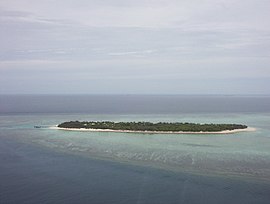Capricorn Islands
|
Capricorn and Bunker Group Queensland |
|
|---|---|

Heron Island from helicopter, looking north-northeast.
|
|
| Coordinates | 23°14′54″S 151°46′41″E / 23.24833°S 151.77806°ECoordinates: 23°14′54″S 151°46′41″E / 23.24833°S 151.77806°E |
| Area | 3.435 km2 (1.3 sq mi) |
The islands and reefs of the Capricorn and Bunker Group are situated astride the Tropic of Capricorn at the southern end of the Great Barrier Reef, approximately 80 kilometres east of Gladstone, which is situated on the central coast of the Gladstone Region, Queensland, Australia.
Many of these islands form part of the Capricornia Cays National Park and are part of the Great Barrier Reef World Heritage Area.
The Capricorn and Bunker group of islands of the southern Great Barrier Reef lies between 45 and 75 km from the adjacent departure ports and urban centres of Yeppoon, Gladstone, Town of 1770 and Bundaberg.
The Capricorn and Bunker groups (including Lady Elliot Island and Reef) are a distinct group of 22 reefs straddling the Tropic of Capricorn, at the southern end of the Great Barrier Reef. There are 16 permanent coral cays on these reefs, including twin cays on Hoskyn and Fairfax Reefs. North West Island (105 hectares) is the largest coral cay in the Great Barrier Reef Marine Park.
The islands have high natural values, notably breeding populations of seabirds, marine turtles and coral cay vegetation.
The Capricorn Group of islands consists of nine coral cays:
Additional to these are several reef structures separate from the individual island but still part of the Capricorn Group of islands including
A tourist Resort and Marine Scientific Research Station have been established on Heron Island. A manned lighthouse operates at North Island and the Australian Museum conducts a field research station on One Tree Island.
The Bunker Group consists of five coral cays:
In association with
...
Wikipedia

